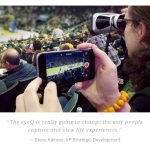Augmented Reality Technology: The Nuts And Bolts
Augmented Reality Technology: The Nuts And Bolts

Augmented reality (AR) is obviously one of the world’s biggest digital stories of all time. The successful release and debut of Pokémon Go happened to be a striking demonstration of the potential abilities of the new technology which is aimed at providing a new and solid platform for customer engagement. This is the mobile game produced by a mobile app development company that brought Augmenter reality (AR) into the limelight.
For the first time in history, developers were able to successfully turn imaginations into reality. Now, many mobile app development companies are following suit. Though Pokémon Go didn’t last that much on the radar, the underlying technology that powered its ascension is not really over as many may be thinking. As a matter of fact, the technology has just begun its course.
Now that some brands are beginning to consider AR for their local marketing initiatives, it is obvious that the technology isn’t just for gamers alone.
What is the technology all about?
Augmented reality (AR) is one aspect of modern technology that is steadily proving its usefulness in daily lives of every technology buff. Due to its wondrous ability to transform the real world with awesome elements from the virtual world, AR is just on the move to enhance the things people feel, hear, and see. While serving as a link between the real world and the virtual world, augmented reality is holding the ace for mixed reality spectrum.
Just so you know, this is a unique technology that seeks to augment the live views (direct or indirect) of the natural environment using superimposed computer-generated images to establish an enhanced version of reality. Basically, it seeks to use images to provide an enhanced version of how individuals perceive reality and view the real world.
When you hear word “augmented,” the first thing that comes to bare is “add something.” This is exactly the principle behind the objectives of this technology. Ultimate, AR is concerned with the use of touch feedback, sounds, and graphics to augment the natural world of its users. In this situation, you don’t need to inhabit a whole virtual environment as is the case with virtual reality.
AR revolves around the use of virtual information to augment, in other words, enhance, the existing natural environment of the user. To this end, users tend to achieve an augmented reality (AR) experience of a whole new and improved world where virtual and real worlds harmoniously relate. In a bid to provide the required assistance in their day to day activities, virtual information is also employed to enhance the augmented reality experience.
Application of AR can be experienced in either a simple fashion such as a text-notification or more complicated manner such providing relevant information/instruction as to how a life-threatening surgical procedure can be effectively performed. Already, many AR app development companies are using this technology to provide accessible and timely data, enhance understandings, and highlight certain features.
It may interest you to know that business apps and smartphone apps are only a few of the numerous applications already driving augmented reality (AR) application development in the industry. It is important to know that the relevancy of this technology in the today’s world of transformations cannot be underestimated as it is gradually going to affect every stratum of human engagement and interaction.
Types of Augmented Reality
At the moment, there are several existing categories of AR technology. It may interest you to know how they employ varying application use cases and objects. Here are some of the various technologies any AR app development company can explore to develop their own augmented reality apps.
Superimposition Based Augmented Reality
Whether partially or dull developed, most AR app development companies employ superimposition based augmented reality to create a newly augmented view of an object that can be used to replace the original view of the very same object. The app will only be able to effectively replace the original view of an object with an augmented one only when it can determine the object model.
So, when it comes to developing AR apps based on superimposition, it is important to understand the role object recognition plays. A typical example of this form of AR technology can be observed in the Ikea augmented reality furniture catalogue. This type of superimposition based AR strategy presents a strong consumer-facing example that enables users to strategically locate virtual Ikea furniture in their own home with the help of augmented reality (AR). All they need to do is to download the app and use it to scan digital or printed catalog in some selected places.
Projection-Based Augmented Reality
With this technology, users can easily get involved with a new form of AR which simply projects artificial light onto real-world surfaces. It allows for human interaction by releasing light onto a real-world surface and then stimulating the human interaction of the projected light through touch or any other means. Most projection-based augmented reality apps are designed to detect user interaction by differentiating between a known or expected project and the altered projection which occurs as a result of the user’s interaction. The use of laser plasma technology to launch an interactive hologram (based on a three-dimensional analysis) into mid-air is another interesting application of projection-based AR.
Markerless Augmented Reality
This technology is one of the most widely utilized applications of augmented reality. Also known as GPS, position based, or location-based, markerless AR employs an accelerometer, velocity meter, digital compass, or GPS embedded in the device to provide data based on the user’s location. The wide availability of mobile devices (tablets and smartphones), as well as their enhanced location detection abilities, have helped to establish a strong force behind the growth and expansion of the markerless augmented reality technology. This technology is commonly featured with location-centric mobile apps that are used for finding nearby businesses and mapping directions.
Marker Based Augmented Reality
Also known as Image Recognition, any AR app development company can employ the marker based AR technology to create application-based results. Basically, it involves the use of a distinct, but simple pattern such as a QR/2D code and a camera to produce results. This is only achievable when a reader is used to sense the marker. The camera on the device plays an important role in helping to distinguish a marker from other real-world objects.
The post Augmented Reality Technology: The Nuts And Bolts appeared first on ReadWrite.
(121)














